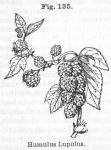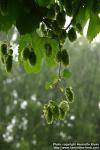
 Preparations: Infusion of Hop
- Tincture of Hops
- Fluid Extract of Hops
Preparations: Infusion of Hop
- Tincture of Hops
- Fluid Extract of Hops
Related entry: Lupulinum (U. S. P.)—Lupulin
"The strobiles of Humulus Lupulus, Linné"—(U. S. P.).
Nat. Ord.—Urticaceae.
COMMON NAME: Hop.
ILLUSTRATION: Bentley and Trimen, Med. Plants, 230.
Botanical Source.—This plant has a perennial root, with many annual, angular stems, rough backward, with minute, reflexed hairs, twining around surrounding objects in a volute direction with the sun, and climbing to a great height. The leaves are opposite, on long, winding, rough petioles; the smaller ones cordate, the larger from 3 to 5-lobed; all are deep-green, serrated, veiny, and very rough. The flowering branches are axillary, angular, and rough. Stipules, 2 or 4, between the petioles, smooth, ovate, and reflexed. The flowers are numerous, axillary, and of a greenish color. Male flowers very numerous, panicled, yellowish-white; sepals 5, oblong, obtuse, spreading, concave; stamens short; anthers oblong, opening by 2 terminal pores. Female flowers pale-green, grow on a separate plant, in the form of an ament, having each pair of flowers supported by a bract, which is ovate, acute, and tubular at the base; sepals solitary, obtuse, smaller than the bracts, enfolding the ovary; ovary roundish and compressed; stigmas 2, long, subulate, and downy. The bracts enlarge into a persistent catkin or strobile, each bract inclosing a nut enveloped in its permanent bractlet, and some yellow, resinous grains (L.—B.).
History and Description.—This plant is common in hedges and thickets in many parts of Europe, and grows spontaneously in various sections of the United States; said also to inhabit China and the Canary Islands. It is largely cultivated for its cones or strobiles, which are used medicinally, and in the manufacture of beer, ale, porter, etc. A few rows of the barren vines planted among the fertile ones, are said to be profitable by increasing the weight of the produce. The strobiles or cones are the parts employed; these are collected when thoroughly matured, properly desiccated, and then placed in large bags or pockets, and sold as Hops. They consist of ovate, membranous, semi-transparent, light-green scales, tinged more or less of a yellow color, which are glandular at their base, near which they develop 2 minute, globular, hard nuts or achenia of a bay-brown color, and which are covered with aromatic, superficial, globose, golden-yellow glands or grains. To these the name lupulin was given by Ives (Amer. Jour. Science, 1820, p. 302). The active properties of hops are owing to the lupulin, although the scales possess them also, but in an inferior. degree. Lupulin (see Lupulinum), is procured by beating or rubbing the strobiles, and then sifting out the grains, which form about 1/7 part of the hops. The official description of hops is as follows:
"Ovate, about 3 Cm. (1 1/6 inch) long, consisting of a thin, hairy, undulated axis, and many obliquely-ovate, membranous scales, in the upper part reticulately veined, and toward the base parallel-veined, glandular, and surrounding a subglobular achene; color of the scales greenish, free from reddish or brownish spots; odor aromatic; taste bitter, aromatic and slightly astringent"—(U. S. P.).
Chemical Composition.—Boiling water takes up the virtues of hops; however, they are impaired by long-continued heat. The decoction turns litmus paper red, becomes deep-green with the salts of iron, and turbid with the solution of isinglass. A better solvent than water is diluted alcohol. By distillation with water, hops yield a limpid volatile oil (0.8 per cent, v. Wagner), lighter than water; Payen and Chevallier (1822) obtained from lupulin 2 per cent. The oil in part contains humulene (a sesquiterpene, C15H24), and unsaturated hydrocarbons not belonging to the terpene series. The formation of butyric and valerianic acids, observed in the distillation of old hops or lupulin with water, is not due to oxidation of the volatile oil (A. C. Chapman, Pharm. Centralh., 1899, p. 73).
A bitter principle was obtained as an amorphous, water-soluble mass, by M. Issleib (Archiv der Pharm., 1880, p. 345), by exhausting lupulin of its bitterness by cold water, abstracting the bitter, with some resin, by animal charcoal, abstracting with alcohol, and separating the bitter from the resin by means of ether, which dissolves the bitter part only. The bitter principle, upon boiling with diluted sulphuric acid, is resolved into brown, amorphous lupuliretin (also supposed to be an oxidation product of the volatile oil), and crystallizable lupulic acid. A crystallizable, bitter principle, called hop-bitter acid, was first obtained pure by Lermer in 1863 (Dingl. Pol. Jour., Vol. CLXIX, p. 54), by an elaborate process. This substance is insoluble in water, soluble in alcohol, ether, chloroform, and other liquids, notably the volatile oil of hops. The same compound was more recently obtained by H. Bungener (Amer. Jour. Pharm., 1884, p. 427, from Pharm. Jour. Trans., 1883-4, p. 1008). Six kilograms of fresh lupulin from unsulphured hops were extracted with low-boiling petroleum ether, and yielded 400 Gm. (6.6 per cent), of crude hop-bitter acid. The pure substance melts at 92° to 93° C. (197.6° to 199.4° F.), and when exposed to the air, soon turns yellow, resinifies, and develops an odor of fatty acids and aldehydes. Oxidizers produce valerianic acid in considerable quantity.
The resins of hops were differentiated by Dr. Hayduck (see Amer. Jour. Pharm., 1888, p. 25, into three resins, two of which are soluble in petroleum-ether and form ether-soluble copper salts. The hop-bitter acid aforementioned is spontaneously convertible into one of these two resins, namely, that which is not precipitated by lead acetate. These two resins, as well as the hop-bitter acid, were established to be the principles antagonistic to lactic ferments, while the oil of hops does not possess such untiseptic properties. A peculiar tannin, called humuli-tannic acid, was found to be present in hops to the extent of 2 to 5 per cent (v. Wagner, 1853, and Etti, 1876). A crystallizable alkaloid was believed by Lermer to exist in hops, although Gresshoff (1887) established its absence in lupulin (see Flückiger, Pharmacognosie, 1891). In this connection, the nature of the poisonous, crystallizable substance abstracted by F. Davis from the green strobiles of hops with ether (Pharm. Jour. Trans., 1896, Vol. XVIII, p. 20), probably deserves further investigation. Other constituents are: Wax (about 10 per cent in lupulin), chlorophyll, dextrose (3 per cent, by Griessmayer, 1874), asparagine (1 per cent, Bungener and Fries, Amer. Jour. Pharm., 1886, p. 91), trimethylamine and choline (C2H4[OH]N[CH3]3OH), lupuline of Griessmayer, 1874); of the latter base, Griess and Harrow obtained from hops 0.02 per cent; diluted aqueous solutions of this substance dissolve comparatively large amounts of hop resin, producing an intensely bitter solution. (Also see Lupulinum for special points.)
Action, Medical Uses, and Dosage.—Hops are tonic, hypnotic, febrifuge, antilithic, and anthelmintic. Their tonic and anthelmintic properties are small, and probably depend upon their bitterness; they possess no antiperiodic virtues. Sometimes they cause diuresis, and are said to correct lithic acid deposits. They are principally used for their sedative or hypnotic action—producing sleep, removing restlessness, and abating pain, but which they often fail to accomplish. A pillow stuffed with hops has long been a popular remedy for procuring sleep. Hops, as well as lupulin, are useful in delirium tremens to allay the morbid excitement and vigilance, while at the same time it exerts its stomachic effects. It is extremely efficient in dyspepsia where restlessness and a brooding disposition are prominent features. Fermentative dyspepsia, with consequent eructations, often yields to hops or lupulin. Externally, in the form of a fomentation alone, or combined with boneset or other bitter herbs, hops have proved beneficial in pneumonia, pleurisy, gastritis, enteritis; also as an application to painful swellings or tumors. An ointment made by boiling 2 parts of stramonium leaves and 1 of hops, in lard, has proved an effectual application in eczema, ulcers, and painful tumors.
Lupulin exerts a more certain influence than hops, and should be preferred for internal use, as the dose is much less bulky. The properties here ascribed to hops are possessed by lupulin, and the conditions benefited by lupulin are also those in which hops act beneficially. The subject will be further discussed under Lupulin (see Lupulinum).
The decoction of hops is seldom employed. Ale, porter, and beer are frequently administered in cases of debility in the absence of inflammatory symptoms, as tonic, stimulant, and nutritive agents. (For specific indications see Lupulinum.)

